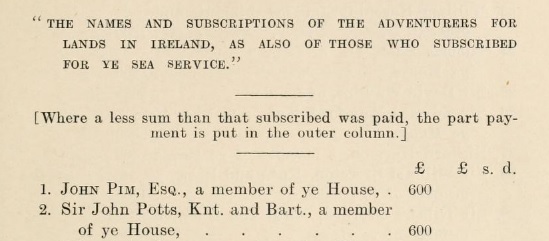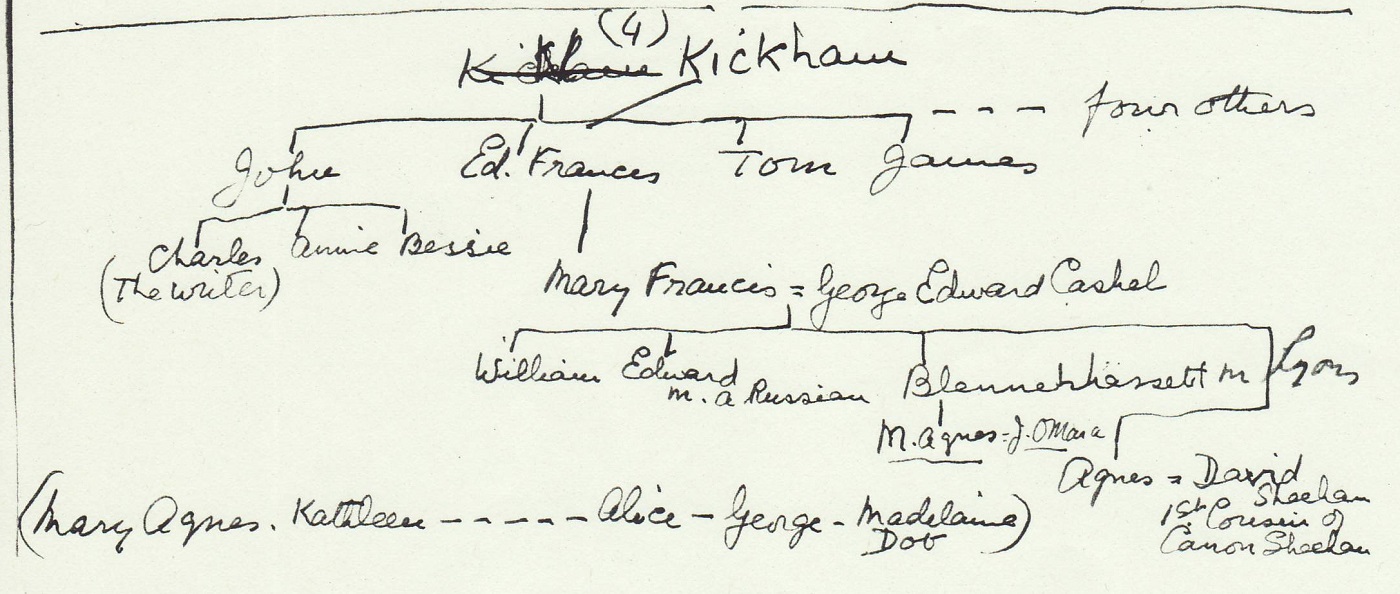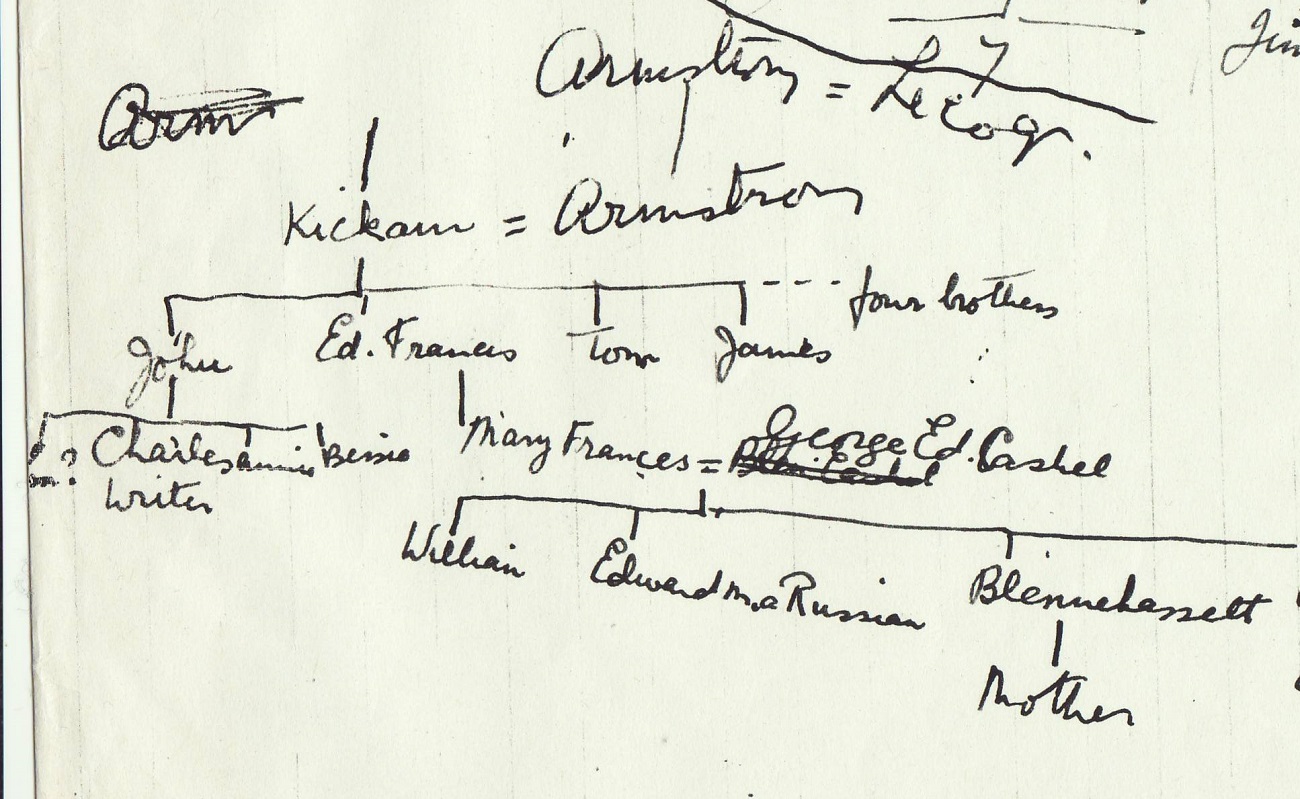Kickham of Mullinahone, Co.Tipperary
Our Kickham family (the Fenian's family) is of SE Co.Tipperary.
Of the area of
Fethard (Fethard par)
and
Mullinahone (Kilvemnon par, near border with Co.Kilkenny).
Page 242 of
[Maher, 1955]
says the family
originated in Kirkham,
Lancashire, NW England.
In England the commonest form is Kirkham,
with variants Kirkam and Kerkham
[Comerford, 1979].
Cromwellian settler
Our Kickham family (the Fenian's family) is said to descend from a Cromwellian settler of the 1650s.
He was Protestant, of the name
Kickham,
or Kirkham.
[Heffernan, 1958]
says he was born in
Lancashire.
He was a
farrier-sergeant in
the
Cromwellian army in
the
Irish Confederate Wars
(1641-1653).
A military farrier was
"an important position involving responsibility
for the welfare of the horses in a cavalry regiment, but it was not
sufficiently prestigious to ensure admission to the ranks of the
colonial gentry"
[Comerford, 1979].
He
received land in Ireland.
[Heffernan, 1958]
says that a
Kickham was Town Clerk of
Cashel, Co.Tipperary, in 1672.
Though
p.242 of
[Maher, 1955]
seems to say that the Cashel municipal archives say "Kirkham".
Link to Cooke and Barton
[Heffernan, 1958]
says the original Kickham
continued to practice as a
vet
in Co.Tipperary,
under the patronage of these two families:
-
Cooke of
Kiltinan Castle,
Kiltinan par
(or Kiltinane),
SE of Fethard, Co.Tipperary.
See Kiltinan in [Irish Country Houses].
See article.
Kiltinan Castle was built in 13th century
by Butler
and was held by
Butler, Baron of Dunboyne.
Cooke acquired it in 1669, leased it out, and then made it their seat from 1681.
See
[Maher, 1955, pp.47-53].
Later a branch of this Cooke family
(though not of Kiltinan) married to
Collis
and became Cooke-Collis.
See Cooke-COLLIS
in [Burkes Irish, 1976].
See Cooke-COLLIS
on pp.122-123
of [Burkes Irish, 1912].
-
Barton of Grove,
SE of Fethard, Co.Tipperary.
Barton acquired it in 1752.
The problem with the original Kickham settler being involved with Cooke or Barton is that
Cooke did not live at Kiltinan until 1681,
and Barton did not acquire Grove until 1752.
So maybe these are linked to later Kickhams
rather than the first settler.
[Cusack]
links Barton to
James Kickham of Knockelly
in the early 19th century.
[Comerford, 1979]
says
"the tradition of the professional horse-handler survived in the family
for a surprisingly long time".

The Cooke seat,
Kiltinan Castle.
From
1887 to 1913 map.
Now Kiltinan Castle Stud.
See modern
satellite view
and
street view
of SW entrance.
Trying to identify an actual Cromwellian settler
This Kickham family is meant to descend from
Kickham,
or Kirkham, a Cromwellian settler.
There is a "Robert Kirkam" of London
listed among
the Cromwellian adventurers for land in Ireland
in 1642 to 1646.
Whether he is the ancestor of this family is not known.


Robert Kirkam, of London,
bowyer.
Listed among the Cromwellian adventurers for land in Ireland in 1642 to 1646.
The "adventurers" paid to get future lands in Ireland.
After the
Cromwellian victory in 1653,
Irish lands were confiscated
and handed out to the adventurers.
From
pp.401-403
and
p.415
of
The Cromwellian settlement of Ireland
by John P. Prendergast (died 1893), 3rd edn, 1922.
- The source is 9 volumes that were burnt in 1922:
- The 9 volumes were written up in 1825:
- "Inrolments of the Certificates for Adventurers, Soldiers, etc."
- This is another collection, indexed in the 1825 report.
See Page 403.
- Page 419
says that a
"Thomas Kirkham"
appears in this collection,
roll xxv,
skin no. 17.
- Presumably this collection was also burnt in 1922.
-
This list is the source for "Kirkham" listed in the
Adventurers for Lands in Ireland 1642-46 on
p.702
of vol.2 of
[O'Hart, 1892].
It is now proven that our family is the same as the Fenian's family.
Proof that Charles Kickham (born 1752) is our ancestor
I call it as
proved
that
Charles Kickham
of Mullinahone (born 1752, died 1815,
grandfather of the Fenian
Charles Joseph Kickham)
is our direct ancestor.
In particular his son
Edward Kickham
is our direct ancestor.
The proof is as follows.
- Start with family records:
- Family records showed we descend from Mary Kickham, daughter of Edward Kickham.
-
Our Kickhams were said to be close relations of the Fenian.
- Pat Lavelle
had a family tree showing the connection.
She said our Edward Kickham was uncle of the Fenian.
-
Bee Sheahan (born 1875)
stayed with Kickham cousins in Mullinahone as a child (would be 1880s).
She had a goat called Charles, after the Fenian
(who died 1882).
It was said that:
"Family didn't approve"
(Of what? The Fenian?
Or disrespect to the Fenian?)
- External records confirmed it:
- Looking through external records strongly confirmed this story.
- We soon discovered proof that Mary's father was an
Edward Kickham of Mullinahone.
- There is no Edward Kickham listed among the Fenian's uncles in
[White, 1955].
However we discovered that only lists some of the uncles.
- We discovered
[Deed, 1812],
which showed the Fenian's uncle Edward Kickham, the eldest son.
- Edward is listed with his brothers in
[Clonagoose Deed, 1817].
-
So there was an Edward, uncle of the Fenian,
son of Charles Kickham (born 1752) of Mullinahone.
-
Our Edward Kickham
had children baptised in Mullinahone 1812 to 1820, so he is the right generation and location
to be this Edward.
- At the baptism of our Edward's son Charles Kickham in 1812, the sponsor is
"Charles the grandfather".
If it was maternal grandfather they would say Charles Armstrong.
So it must be Charles Kickham the paternal grandfather.
So our Edward was son of Charles.
Note that Charles Kickham, born 1752, died in 1815.
- Maybe I should have regarded it as already proven,
but I still looked for final proof.
- DNA proves it:
- DNA finally provided the proof in 2019.
- In 2019, I discovered DNA matches between
our family and
Edward Blatchford,
descendant of Maria Kickham, sister of the Fenian.
- In further years, I discovered strong DNA matches between
our family and
descendants of
Alexander Kickham, brother of the Fenian.
- So we have a strong DNA link to
descendants of John Kickham,
brother of what the paper evidence says is our Edward Kickham.
Our matches to the Fenian's family are as follows (ones above 11 cM marked):
Between the paper evidence and the DNA,
I call this link as proved.
Pat Lavelle was right.
Edward Kickham is uncle of the Fenian.
Nothing else is plausible.
The Cromwellian farrier above is
ancestor somehow of:
-
--- Kickham,
Protestant,
had issue:
-
James Kickham,
Protestant,
of Knockelly Castle, near Fethard, Co.Tipperary.
-
Charles Kickham,


of Mullinahone, Co.Tipperary,
born 1752,
Protestant.
Grandfather of the Fenian Charles Joseph Kickham.
The standard theory is that Charles and James are Protestant.
But see
below
for a theory that the Kickhams may have converted to Catholicism
in an earlier generation.

Kickham tree from
Pat Lavelle
(died 1966)
in
[PAT/7, no.1]
and
[PAT/13, no.4].
She shows our Edward Kickham
as uncle of the Fenian.
Over 50 years later, in 2019,
DNA analysis finally proved this is true.

Kickham tree in
[PAT/13, no.2]
also shows our Edward Kickham
as uncle of the Fenian.
Though she attaches Armstrong to the wrong generation.
Armstrong is definitely Edward Kickham's wife.
In
[PAT/13, no.1]
and
[PAT/12, p.18]
she shows George Cashel's wife as aunt of the Fenian instead of the correct relationship, 1st cousin.
The below Kickham family
are of
Kilvemnon
(some distance S of Mullinahone, where the graveyard is).
This family
have a tradition of being related to the Fenian Kickham family of Mullinahone.
We would easily believe that any Kickham family in the neighbourhood is related.
It is not a common name.
And now we have strong DNA matches which suggest the two families are
very close relations.
Proof that Kickham of Kilvemnon are related to our family (and the Fenian's family)
There are multiple DNA matches between Kickham of Kilvemnon and our family.
They are as follows (ones above 11 cM marked):
So our family is related by DNA to both
Kickham of Kilvemnon and the Fenian Kickhams.
The two families are related, and very closely.
Do we descend from Kickham of Kilvemnon?
At an earlier stage of the research,
the DNA matches of our family with Kickham of Kilvemnon
looked
better
than the DNA matches of our family with the Fenian's family.
So we considered the theory that we might descend from Kickham of Kilvemnon,
and the Fenian's family would just be close relations.
We dismiss this theory for the following reasons:
-
DNA is not all we have.
We have documentary evidence that we descend from a
Charles Kickham
who has a son
Edward Kickham
who has children bapt 1812 to 1820.
This perfectly fits Edward son of Charles in the Fenian's family.
It does not fit the Kilvemnon family.
Such a tree cannot fit in below Laurence of Kilvemnon (born 1770).
- Further DNA matches eventually came in,
so that the strongest DNA matches are now with the Fenian's family.
So we believe we have proved our descent is from the Fenian's family
(from Edward Kickham, uncle of the Fenian).
But it does show that
Laurence Kickham of Kilvemnon (born 1770) must be very closely related to
Charles Kickham (born 1752), maybe a younger brother.
Note that the eldest son of both appears to be Edward.
According to the Irish naming pattern,
it looks like the father of Laurence and Charles would be an Edward Kickham.
Did the Kickham family go Catholic earlier?
The DNA suggests that
Laurence of Kilvemnon is probably a brother of Charles (born 1752).
But then consider the brothers' religions:
- James Kickham of Knockelly Castle: Protestant.
Though maybe identical with his supposed son James Kickham who
marries a Catholic and has Catholic children.
- Charles Kickham (born 1752): Protestant.
Marries a Catholic and has Catholic children.
- Laurence Kickham:
Marries a Catholic and has Catholic children.
- Maybe Thomas Kickham:
Marries a Catholic and has Catholic children.
Aren't there a lot of Protestant Kickham brothers marrying Catholics?
Perhaps a simple explanation is that none of these Kickhams are Protestant.
But rather the conversion of Kickham to Catholicism happened a generation earlier.
Probably a brother of James and Charles above:
-
Laurence Kickham,

born 1770, Catholic.
Farmer at Kilvemnon, some distance S of Mullinahone.
Had children bapt 1809 to 1816.
Laurence is probably a close relation of the following Thomas.
Why? Because Thomas and Laurence baptise children on the same day, 8 May 1816.
Laurence names his son
Thomas.
Thomas names his son Laurence.
They are probably brothers.
- Thomas Kickham,
mar Ellen O'Neill [or Ellen Neill, or Ellenor],
had issue:
- Martin Kickham,
bapt 28 Oct 1812
[Mullinahone RC par records],
sp John Dillon and Ellen Shee.
- John Kickham,
bapt 5 May 1814
[Mullinahone RC par records],
sp Michael Kickham and Margaret Kickham.
- Laurence Kickham,
bapt 8 May 1816
[Mullinahone RC par records],
sp James Neill and Honor Neill.
- Mary Kickham,
bapt 14 Apr 1819
[Mullinahone RC par records],
sp Henry Neill and Honor Neill.

The double baptism on 8 May 1816.
From
here.
And
here.
References
- Papers of Patricia Lavelle.
- Charles J. Kickham, R.V. Comerford, Wolfhound Press, 1979.
- James Maher (died 1977)
- The Valley near Slievenamon, ed. James Maher, Mullinahone, 1942.
[NLI] Ir 828 k2.
- Romantic Slievenamon,
ed. James Maher, Mullinahone, 1954.
Reprint 1955.
[NLI] Ir 94142 m2.
- Published in Maher:
- Michael Larkin
- Michael Larkin,
Mullinahone, its Heritage and History,
Clonmel, 2002.
- Michael and Nora Larkin,
Mullinahone Parish: Burial Grounds,
Clonmel, 2005.





